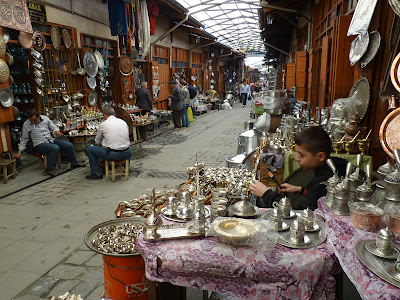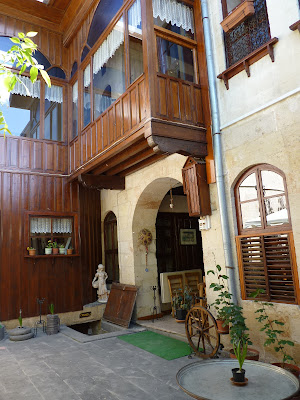 |
| Starbucks Not |
Gaziantep, 40 miles from the Syrian border in Southeastern Turkey has been in the news lately as a staging ground for journalists covering the war, a refugee center, and a gateway city for ISIS recruits on their way to Syria.
"It’s a destination for spies and refugees, insurgent fighters and rebel leaders, foreign-aid workers and covert jihadists—all enmeshed in Syria’s multisided war," is how the New Yorker's Robin Wright described it in 2014.
Before the war, Gaziantep or "Tep" as the Turkish call it, was a sophisticated and cosmopolitan city, known as the culinary capital of Turkey. Its claim to fame was being home to the world’s finest baklava, the honey-soaked pastry. People from Istanbul came for the weekend, the way we might go to Portland or San Francisco. The old city is filled with beautifully-restored 16th century mosques, inns and 19th century stone mansions. Like many of the cities in this area, Gaziantep was an important trading center with its Middle Eastern neighbors and China. It was a stop on what was known as the second Silk Road that went to China via Iran and Afghanistan.
"It’s a destination for spies and refugees, insurgent fighters and rebel leaders, foreign-aid workers and covert jihadists—all enmeshed in Syria’s multisided war," is how the New Yorker's Robin Wright described it in 2014.
Before the war, Gaziantep or "Tep" as the Turkish call it, was a sophisticated and cosmopolitan city, known as the culinary capital of Turkey. Its claim to fame was being home to the world’s finest baklava, the honey-soaked pastry. People from Istanbul came for the weekend, the way we might go to Portland or San Francisco. The old city is filled with beautifully-restored 16th century mosques, inns and 19th century stone mansions. Like many of the cities in this area, Gaziantep was an important trading center with its Middle Eastern neighbors and China. It was a stop on what was known as the second Silk Road that went to China via Iran and Afghanistan.
Some serious money went into restoring the Ottoman-era bazaar quarter filled with spice and nut sellers and craftsmen turning out everything from rolling pins to baklava in the back of little storefront shops. When I visited in 2011, I was thrilled to come upon this coffee seller with his copper urn. Men dress up like this in Istanbul to pose for pictures with tourists, but this guy was the real deal. Notice the string of paper cups around his neck. He opened the lid on the urn to show me hot coals in the bottom keeping the coffee hot. The coffee, called murra, was thick, sweet and scented with spices. I was about to buy a cup, when the coppersmith on the left, bought one for me, the posted for a photo with his cat.
 |
| Pistachio sweets for sale |
Baklava, Kadayif, and other similar sweets made with pinkish, half-ripe pistachios, are to Gaziantep what coffee is to Seattle. There are more than 150 shops, one or two every block it seems. Imam Cagdas, a big busy shop founded in 1887, ships its baklava worldwide, but we preferred the smaller, one-man shops where you either order a box to go, or eat it there at one of a few tables in the back. Most keep things simple and offer little else besides water or tea.
 |
| Artisan at work |
It's common in bazaars and markets around the world to see craftsmen working in front of shops selling products made in China or mass-produced in factories, but that's not the case in Gaziantep. Everything you see is made in the workshops, from cutting sheets of copper, to pounding, plating and etching the designs. The more intricate the design, the more expensive the piece. We paid about $6 each for two small, hand-pounded copper pans.
 |
| Copper bazaar |
A few of the old mansions have been turned into boutique hotels. Below is the Asude Konak where my husband and I stayed. It took the owners 10 years to restore the 108-year-old house into a five-room inn on a pedestrian street above the town center.
 |
| Aside Konak B&B |
The owner, Jale, below right, loves to cook and guests can arrange to have dinner here. It was Mother's Day, so she invited us and another couple to join in a family kebab party - sort of like a Sunday barbeque. She and her mother, left, made a half-dozen different kinds of kebabs, including our favorite, eggplant and lamb, along with plums and lamb and another with roasted garlic.
 |
| Kebab party in the making |
They filled the rest of along table on their outdoor patio with plates of fresh greens and mint, yogurt dips, bread and salads. Some drank Raki, a high-powered anise liquor that produces a cloudy drink when mixed with water. Others had Ayran, the refreshing yogurt drink made with water and a dash of salt. Antep is surrounded by fertile farmland and has a climate ideal for growing olives, pomegranates, many types of fruits and vegetables and raising sheep. There's an excellent culinary museum with explanations in English of all the local dishes. We didn't find it until our last day, but if I had it to do over again, I'd go there first-thing, so that I'd know more before setting out for the restaurants and markets.
 |
| Sunday barbeque |
After a quick flight to Izmir on the Aegean coast, we spent our last couple of days in the little town of Selcuk. The reason to come is to see the ancient Greek and Roman city of Ephesus, two miles away. Selcuk is a pleasant little low-key tourist town with lots of small hotels and restaurants. The downside is that we were back in Tour Bus Turkey, land of genuine fake watches and the art of the upsell. Most of the hotels offer a "free'' ride to Ephesus which turns out to be provided by the owner of a carpet shop.
 |
| Ephesus |
As impressive as walking through the ruins was, we couldn't help but contrast the touristy atmosphere here with the the we spent Southeastern Turkey. They seemed more genuine and real, interesting for their history, religious traditions and present-day culture influenced by their proximity to the Middle East. It may be a while before these areas make it onto tourist itineraries again. Terrorism and ISIS threats, the government's war with Kurdish separatists, a refugee crisis and the proximity of the Syrian war have just about killed tourism all over the country. Cruise ships are rerouting, and hotel bookings have plunged. Hopefully Gazientep won't be a permanent casualty of the conflicts. I hope to return, and when I do, stock up on some of the world's best kebabs and Baklava.
















































